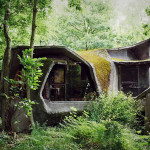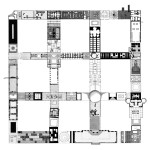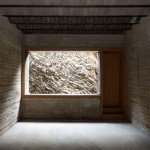Beyond blogging | A List of Analogies
beyond blogging | davide tommaso ferrando
This post belongs to a series of interviews aimed at investigating the ideas that stand behind a selection of editorial projects dedicated to architecture and based on an experimental use of social networks such as Tumblr, Facebook and Instagram. As summarized by the title of this cycle, “beyond blogging”, we believe that the critical use of social tools is leading architectural communication to a new and promising fronteer: one in which the specific features of digital media – fast reading, relevance of the image, easiness of association, informality, viral propagation, etc. – are successfully capitalized to create inspiring architectural archives organized around specific topics, which can efficiently provide useful references for design and research tasks. Even more interestingly, the greatest part of what is published in these “one-man-webzines” is not produced by their editors (who therefore have little or no direct interest in the diffusion of their posts), but is rather the result of independent and unpaid investigations, autonomously conduced on both paper and digital sources. From this point of view, these editorial projects have the great merit of being constantly enriching the web with diverse and previously unpublished architectural references, coming from both the present and the far-away past. Their aim, therefore, is not to keep their readers updated, but to produce a connotative kind of architectural knowledge: one in which it is not the single images that count, but the relations that can be established among them. Our fourth interviewee is Valter Scelsi, editor of A List of Analogies. DTF

Fig. 1 Marcel Duchamp, Rotorelief from Anemic Cinema, 1926
Site: A List of Analogies
Platform: Tumblr
Editor: Valter Scelsi
I. Personal info
Can you introduce yourself? (how old are you? What did you study? What did/do you do?)
I’m an architect and researcher. I teach architectural design at the University of Genova, where I studied. From 2001 to 2011 I run an architectural firm: Sp10 (we were two partners at the beginning, four at the end).
Can you explain in what does your editorial activity consist?
I put together images that seem to me to contain analogies.
How long have you been dedicating yourself to your editorial activity?
Since the spring of 2014.
Does your editorial activity have effects on your profession?
I started too recently to assess the effects. However, for sure it is a way for studying.

Fig. 2 Valentina Gugole, Villa Bombrini and Ilva steel factory, 2007
II. Work method
How much time do you dedicate, on average, to your editorial activity?
For some time, about an hour a day.
Where and how do you look for the material you publish?
Half of it comes from my books or image archives, and half of it from websites. In any case, blogging is my way of mediating archives and research.
Have you developed and consolidated some personal publishing tehcnique?
Sometimes when I see an image another one springs to my mind. In my opinion, the problem is defining the border of analogy’s existence. Regarding the technical operation of the blog, I usually follow two kinds of strategy: to simply reblog from other sites, or to post myself two or more images. When the latter is the case, I also write new captions at the end of the post.
The links/projects/images you share are usually actual or they belong to the past?
It depends: if I have to choose between a historic image and a recent photo of the same building, I usually choose the former. But if the recent photo is a good photo, for example, I go for the latter. But I haven’t real preferences regarding the age of the architectures that I post.
Do you comment what you publish?
No, almost never. Just short captions with the essential data.

Fig. 3 Casa Malaparte
III. Theory
What is the reason that makes you publish?
I was looking for a way to reproduce the analog system that was in my head without weighing it too much with other meanings. At the same time, I wanted the editorial process to maintain a reversible character (in any time I can change or delete an image).
Who do you want to communicate with, when you publish?
Basically with those who I don’t know personally.
What value do you give to the likes/retweets you receive?
The value they deserve, I guess. I think consensus and focus on are natural consequences, and inevitable in some way, of publishing activity.
How do friendships influence you, when you have to choose what to publish?
When I started, I thought I would publish many works of my friends, or works suggested by them. But eventually that wasn’t the case, maybe because with friends you are more critical, or you have more modesty. In any case, with the passing of time the number of friend-advisors is becoming larger.
Did you discover/learn something, while developing your editorial activity?
I have learned so many things that I can’t make a list (or, the list is the blog: A List of Analogies). The blog simply contains a collection of examples, a tentative list of collective architectural themes, useful for everybody and ready to be copied. The number of analogies for each post is not fixed: sometimes they are two, while other times they are three or more. The real surprise is that the chain of analogies seems to self-feed itself.
Do you care that what you publish can influence the architects that follow you?
I think it is inevitable, even just in a small way, and I do not mind.
Do you think that social networks can change the way in which we design?
Everything changes the way in which we design – also the way in which we design.
What is, in your opinion, the role of social networks, in the wider context of architectural communication?
It’s as if the images are freeing themselves from the words that enveloped them. Without the words, some images succumb, while others miraculously thrive. Right now, the incomplete understanding of the web’s behavioral patterns allows a certain level of innocence. I’m afraid that when criticism will come back to completely control the market, we will regret this times of ours.
What is your point of view on the actual state of paper architecture magazines?
I am a contributor of San Rocco, which is a paper magazine, and I founded Asinello Press (with baukuh and Space Caviar): an open publishing platform that relies on manual processes and obsolete technologies to produce experimental, low-budget, short print-run publications with artists and architects. Today the major magazines (Domus, for example) seem to me like gorgeous cetaceans finished in shallow water, and this makes me suffer. In magazines, architectural criticism has faded into the background in favor of a kind of obsession for news, but today paper is both too slow for the news and too heavy for the images (an issue of Domus weighs more than my laptop).

Fig. 4 Il Cortile del Belvedere
IV. References
What are your main paper sources of information, regarding architecture?
Books, for sure, and archives of XX and XIX Century’s magazines, from G to Log, and through, just for example, A+U,Casabella, Metron, Spazio e Società.
Can you indicate the names of one or more actual architects that particularly interest you?
All the participants in the San Rocco’s Book of Copies, for instance. Or a number of Italian architects born in the 40s. One for each group: baukuh and Francesco Venezia.
Can you indicate the names of one or more “sharers” you follow?
Retro-Geographie, Padania Classics, Archive of Affinities and KooZA/rch.

Fig. 5 La Tomba dei Metelli
V. Attachments
Can you choose 5 images, among all that you have shared until now, that are particularly relevant to you?
Fig. 1 – Marcel Duchamp’s Rotorelief, showed me for the first time by Edoardo Sanguineti.
Fig. 2 – Villa Bombrini and Ilva steel factory photograped in 2007 (before the demolition of the gasometer) by Valentina Gugole.
Fig. 3, 4 and 5 – Casa Malaparte, il Cortile del Belvedere, la tomba dei Metelli: a synthetic way to say architecture.
… Grazie!
Related Posts
Questo sito usa Akismet per ridurre lo spam. Scopri come i tuoi dati vengono elaborati.








Lascia un commento